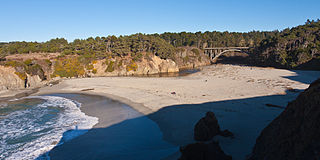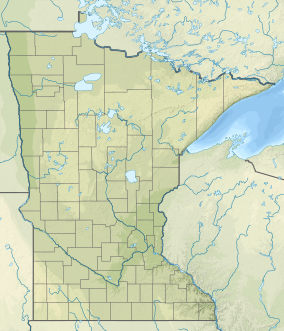Athens Township is a township in Isanti County, Minnesota. The population was 2,322 in the 2000 census.

An oak savanna is a type of savanna—or lightly forested grassland—where oaks are the dominant trees. The terms "oakery" or "woodlands" are also used commonly, though the former is more prevalent when referencing the Mediterranean area. These savannas were maintained historically through wildfires set by lightning, humans, grazing, low precipitation, and/or poor soil.

Fire ecology is a scientific discipline concerned with the effects of fire on natural ecosystems. Many ecosystems, particularly prairie, savanna, chaparral and coniferous forests, have evolved with fire as an essential contributor to habitat vitality and renewal. Many plant species in fire-affected environments use fire to germinate, establish, or to reproduce. Wildfire suppression not only endangers these species, but also the animals that depend upon them.

The National Natural Landmarks (NNL) Program recognizes and encourages the conservation of outstanding examples of the natural history of the United States. It is the only national natural areas program that identifies and recognizes the best examples of biological and geological features in both public and private ownership. The program was established on May 18, 1962, by United States Secretary of the Interior Stewart Udall.
The Long Term Ecological Research Network(LTER) consists of a group of over 1800 scientists and students studying ecological processes over extended temporal and spatial scales. Twenty-eight LTER sites cover a diverse set of ecosystems. It is part of the International Long Term Ecological Research Network (ILTER). The project was established in 1980 and is funded by the National Science Foundation. Data from LTER sites is publicly available in the Environmental Data Initiative repository and findable through DataONE search.

Big Bog State Recreation Area, a recent addition to the Minnesota state park system, is located on Minnesota State Highway 72, north of Waskish, Minnesota. It covers 9,459 acres (38.3 km2), primarily swamps, bogs, and upland "islands".

Raymond Laurel Lindeman was an ecologist whose graduate research is credited with being a seminal study in the field of ecosystem ecology, specifically on the topic of trophic dynamics.

George David Tilman, ForMemRS, is an American ecologist. He is Regents Professor and McKnight Presidential Chair in Ecology at the University of Minnesota, as well as an instructor in Conservation Biology; Ecology, Evolution, and Behavior; and Microbial Ecology. He is director of the Cedar Creek Ecosystem Science Reserve long-term ecological research station. Tilman is also a professor at University of California, Santa Barbara's Bren School of Environmental Science & Management.

The Konza Prairie Biological Station is a 8,616-acre (3,487 ha) protected area of native tallgrass prairie in the Flint Hills of northeastern Kansas. "Konza" is an alternative name for the Kansa or Kaw Indians who inhabited this area until the mid-19th century. The Konza Prairie is owned by The Nature Conservancy and Kansas State University.

National Ecological Observatory Network (NEON) is a large facility program operated by Battelle Memorial Institute and funded by the National Science Foundation. In full operation since 2019, NEON gathers and provides long-term, standardized data on ecological responses of the biosphere to changes in land use and climate, and on feedback with the geosphere, hydrosphere, and atmosphere. NEON is a continental-scale research platform for understanding how and why our ecosystems are changing.
Keeley Creek Natural Area is a Research Natural Area and a National Natural Landmark that is protected by the United States Department of Agriculture, specifically through the branch of the Forest Service. It is located in Stony River Township, in Lake County, Minnesota, and is part of the Superior National Forest.
Lac la Croix Research Natural Area is a natural area that is protected by the United States Department of Agriculture, specifically through the branch of the Forest Service. It was established in 1942 and consists of 973 acres (3.94 km2) of land. It is located in St. Louis County, Minnesota and is part of the Superior National Forest.
Lake Agassiz Peatlands Natural Area is a 25,411-acre (10,283 ha) National Natural Landmark located in Koochiching County, Minnesota. Designated in November 1965 under the Historic Sites Act, its ownership and oversight are provided by the National Park Service of the United States. This designation from the United States Secretary of the Interior, gives it recognition as an outstanding example of the nation's natural history. The designation describes it as
An example of the extensive peatlands occupying the bed of ancient glacial Lake Agassiz, illustrating the process of peat accumulation over about 11,000 years. The area contains Myrtle Lake Bog, which developed contrary to the usual successional process of lake filling, and is an excellent example of both raised and string bogs.

The Upper Midwest forest–savanna transition is a terrestrial ecoregion that is defined by the World Wildlife Fund. An oak savanna plant community located in the Upper Midwest region of the United States, it is an ecotone between the tallgrass prairies to the west and the temperate deciduous forests to the east. A part of the Upper Mississippi River basin, it is considered endangered with less than 5% of the original ecosystem remaining intact, due mostly to overgrazing and conversion to agriculture.

Jug Handle State Natural Reserve is a state park unit of California, United States, preserving a series of marine terraces each exhibiting a different stage of ecological succession. It is located on California State Route 1 north of the village of Caspar, five miles (8 km) equidistant between the towns of Mendocino and Fort Bragg. The 776-acre (314 ha) park was established in 1976.

The H.J. Andrews Experimental Forest, commonly referred to as Andrews Forest, is located near Blue River, Oregon, United States, and is managed cooperatively by the United States Forest Service's Pacific Northwest Research Station, Oregon State University, and the Willamette National Forest. It was one of only 610 UNESCO International Biosphere Reserves, until being withdrawn from the program as of June 14, 2017, and a Long Term Ecological Research site. It is situated in the middle of the Western Cascades.
Sarah E. Hobbie is an American ecologist, currently at the University of Minnesota, a National Academy of Sciences Fellow for Ecology, Evolution and Behavior in 2014 and a formerly Minnesota McKnight Land-Grant Professor.
Martha Crone (1894–1989) was an American botanist and horticulturist.
Cora Alta Ray Corniea (1889–1958) was an American conservationist best known for her role in preserving the Cedar Bog at what is now known as the Cedar Creek Ecosystem Science Reserve in Minnesota. Corniea was referred to as "The Bird Woman of Cedar Bog."













